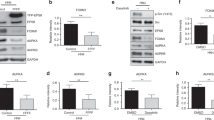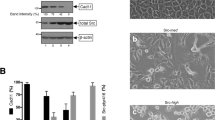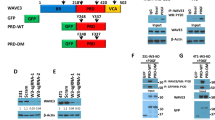Abstract
The Src homology 2 phosphotyrosyl phosphatase (SHP2) is a nonreceptor-type phosphatase that acts as a positive transducer of receptor Tyr kinase (RTK) signaling, particularly the Ras-REK and PI3K-Akt pathways. Recently, we have demonstrated that SHP2 is required for cell transformation induced by the constitutively active fibroblast growth factor receptor 3 (K/E-FR3) (Oncogene, 22, 6909–6918). In that study, we had detected a phosphotyrosyl protein of ∼100 KDa (p100) in cells expressing dominant-negative SHP2 (R/E-SHP2), but its identity and relevance in SHP2-meditaed transformation was not known. Here, we report the identification of p100 as α-catenin, a vinculin-related protein involved in adherens junction-mediated intercellular adhesion. We show that α-catenin becomes Tyr phosphorylated in intercellular adhesion-dependent manner and this event is counteracted by SHP2. Substrate trapping in intact cells and immunocomplex phosphatse assays confirmed that α-catenin is in deed an SHP2 substrate. Tyr phosphorylation of α-catenin enhances its translocation to the plasma membrane and its interaction with β-catenin, leading to enhanced actin polymerization and stabilization of adherens junction-mediated intercellular adhesion, a phenomenon commensurate with loss of the transformation phenotype. Site-directed mutagenesis studies also suggested that Tyr phosphorylation of α-catenin enhances its inhibitory role on cell transformation. Based on our previous work and the current report, we demonstrate that mediation of cell transformation by SHP2 is a complex process that involves modulation of the Ras-ERK and PI3K-Akt signaling pathways, intercellular adhesion, focal adhesion and actin cytoskeletal reorganization. To our knowledge, this is the first report showing regulation of α-catenin function by Tyr phosphorylation and its inhibitory effect on cell transformation.
This is a preview of subscription content, access via your institution
Access options
Subscribe to this journal
Receive 50 print issues and online access
$259.00 per year
only $5.18 per issue
Buy this article
- Purchase on Springer Link
- Instant access to full article PDF
Prices may be subject to local taxes which are calculated during checkout







Similar content being viewed by others
References
Aberle H, Butz S, Stappert J, Weissig H, Kemler R, Hoschuetzky H . (1994). J Cell Sci 107 (Part 12): 3655–3663.
Aberle H, Schwartz H, Hoschuetzky H, Kemler R . (1996). J Biol Chem 271: 1520–1526.
Abutaily AS, Collins JE, Roche WR . (2003). J Pathol 201: 355–362.
Agazie Y, Ischenko I, Hayman M . (2002). Oncogene 21: 697–707.
Agazie YM, Hayman MJ . (2003a). J Biol Chem 278: 13952–13958.
Agazie YM, Hayman MJ . (2003b). Mol Cell Biol 23: 7875–7886.
Agazie YM, Movilla N, Ischenko I, Hayman MJ . (2003). Oncogene 22: 6909–6918.
Alonso A, Sasin J, Bottini N, Friedberg I, Osterman A, Godzik A et al. (2004). Cell 117: 699–711.
Anastasiadis PZ, Reynolds AB . (2000). J Cell Sci 113 (Part 8): 1319–1334.
Araki T, Nawa H, Neel BG . (2003). J Biol Chem 278: 41677–41684.
Barth AI, Nathke IS, Nelson WJ . (1997). Curr Opin Cell Biol 9: 683–690.
Bellus GA, Spector EB, Speiser PW, Weaver CA, Garber AT, Bryke CR et al. (2000). Am J Hum Genet 67: 1411–1421.
Bennett AM, Hausdorff SF, O'Reilly AM, Freeman RM, Neel BG . (1996). Mol Cell Biol 16: 1189–1202.
Bentires-Alj M, Paez JG, David FS, Keilhack H, Halmos B, Naoki K et al. (2004). Cancer Res 64: 8816–8820.
Bullions LC, Notterman DA, Chung LS, Levine AJ . (1997). Mol Cell Biol 17: 4501–4508.
Cleghon V, Feldmann P, Ghiglione C, Copeland TD, Perrimon N, Hughes DA et al. (1998). Mol Cell 2: 719–727.
Cunnick JM, Dorsey JF, Munoz-Antonia T, Mei L, Wu J . (2000). J Biol Chem 275: 13842–13848.
D'Ambrosio D, Hippen KL, Minskoff SA, Mellman I, Pani G, Siminovitch KA et al. (1995). Science 268: 293–297.
Deb TB, Wong L, Salomon DS, Zhou G, Dixon JE, Gutkind JS et al. (1998). J Biol Chem 273: 16643–16646.
Feng GS, Hui CC, Pawson T . (1993). Science 259: 1607–1611.
Feng GS, Pawson T . (1994). Trends Genet 10: 54–58.
Frearson JA, Alexander DR . (1998). J Exp Med 187: 1417–1426.
Hadari YR, Kouhara H, Lax I, Schlessinger J . (1998). Mol Cell Biol 18: 3966–3973.
Hakak Y, Hsu YS, Martin GS . (2000). Oncogene 19: 3164–3171.
Hinck L, Nathke IS, Papkoff J, Nelson WJ . (1994). J Cell Biol 125: 1327–1340.
Hof P, Pluskey S, Dhe-Paganon S, Eck MJ, Shoelson SE . (1998). Cell 92: 441–450.
Hu P, O'Keefe EJ, Rubenstein DS . (2001). J Invest Dermatol 117: 1059–1067.
Hubbard SR, Till JH . (2000). Annu Rev Biochem 69: 373–398.
Inagaki K, Yamao T, Noguchi T, Matozaki T, Fukunaga K, Takada T et al. (2000). EMBO J 19: 6721–6731.
Ireton RC, Davis MA, van Hengel J, Mariner DJ, Barnes K, Thoreson MA et al. (2002). J Cell Biol 159: 465–476.
Kapus A, Di Ciano C, Sun J, Zhan X, Kim L, Wong TW et al. (2000). J Biol Chem 275: 32289–32298.
Kobielak A, Fuchs E . (2004). Nat Rev Mol Cell Biol 5: 614–625.
Kodama A, Matozaki T, Fukuhara A, Kikyo M, Ichihashi M, Takai Y . (2000). Mol Biol Cell 11: 2565–2575.
Krautwald S, Buscher D, Kummer V, Buder S, Baccarini M . (1996). Mol Cell Biol 16: 5955–5963.
Kuhne MR, Pawson T, Lienhard GE, Feng GS . (1993). J Biol Chem 268: 11479–11481.
Lacalle RA, Mira E, Gomez-Mouton C, Jimenez-Baranda S, Martinez AC, Manes S . (2002). J Cell Biol 157: 277–289.
Lechleider RJ, Sugimoto S, Bennett AM, Kashishian AS, Cooper JA, Shoelson SE et al. (1993). J Biol Chem 268: 21478–21481.
Li C, Chen L, Iwata T, Kitagawa M, Fu XY, Deng CX . (1999). Hum Mol Genet 8: 35–44.
Merdek KD, Nguyen NT, Toksoz D . (2004). Mol Cell Biol 24: 2410–2422.
Mohi MG, Williams IR, Dearolf CR, Chan G, Kutok JL, Cohen S et al. (2005). Cancer Cell 7: 179–191.
Morton RA, Ewing CM, Nagafuchi A, Tsukita S, Isaacs WB . (1993). Cancer Res 53: 3585–3590.
Nathke IS, Hinck L, Swedlow JR, Papkoff J, Nelson WJ . (1994). J Cell Biol 125: 1341–1352.
Neel BG, Gu H, Pao L . (2003). Trends Biochem Sci 28: 284–293.
O'Reilly AM, Neel BG . (1998). Mol Cell Biol 18: 161–177.
O'Reilly AM, Pluskey S, Shoelson SE, Neel BG . (2000). Mol Cell Biol 20: 299–311.
Ozawa M, Ohkubo T . (2001). J Cell Sci 114 (Part 3): 503–512.
Salmeen A, Andersen JN, Myers MP, Tonks NK, Barford D . (2000). Mol Cell 6: 1401–1412.
Saxton TM, Ciruna BG, Holmyard D, Kulkarni S, Harpal K, Rossant J et al. (2000). Nat Genet 24: 420–423.
Saxton TM, Henkemeyer M, Gasca S, Shen R, Rossi DJ, Shalaby F et al. (1997). EMBO J 16: 2352–2364.
Schaeper U, Gehring NH, Fuchs KP, Sachs M, Kempkes B, Birchmeier W . (2000). J Cell Biol 149: 1419–1432.
Seki N, Hashimoto N, Suzuki Y, Mori S, Amano K, Saito Y . (2002). Arterioscler Thromb Vasc Biol 22: 1081–1085.
Tang TL, Freeman Jr RM, O'Reilly AM, Neel BG, Sokol SY . (1995). Cell 80: 473–483.
Tartaglia M, Niemeyer CM, Fragale A, Song X, Buechner J, Jung A et al. (2003). Nat Genet 34: 148–150.
Tavormina PL, Bellus GA, Webster MK, Bamshad MJ, Fraley AE, McIntosh I et al. (1999). Am J Hum Genet 64: 722–731.
Tomic S, Greiser U, Lammers R, Kharitonenkov A, Imyanitov E, Ullrich A et al. (1995). J Biol Chem 270: 21277–21284.
Tonks NK . (2003). FEBS Lett 546: 140–148.
Tonks NK, Neel BG . (2001). Curr Opin Cell Biol 13: 182–195.
Turner CE . (2000). Nat Cell Biol 2: E231–E236.
Vasioukhin V, Bauer C, Degenstein L, Wise B, Fuchs E . (2001). Cell 104: 605–617.
Acknowledgements
We thank Dr Fred Minnear (West Virginia University) for providing us with the α-catenin cDNA. We would also like to thank Karen hays for her technical assistance. This work was supported by startup funds from the West Virginia University and by the COBRE (NIH) Grant to YMA.
Author information
Authors and Affiliations
Corresponding author
Rights and permissions
About this article
Cite this article
Burks, J., Agazie, Y. Modulation of α-catenin Tyr phosphorylation by SHP2 positively effects cell transformation induced by the constitutively active FGFR3. Oncogene 25, 7166–7179 (2006). https://doi.org/10.1038/sj.onc.1209728
Received:
Revised:
Accepted:
Published:
Issue Date:
DOI: https://doi.org/10.1038/sj.onc.1209728
Keywords
This article is cited by
-
Conditional knockout of SHP2 in ErbB2 transgenic mice or inhibition in HER2-amplified breast cancer cell lines blocks oncogene expression and tumorigenesis
Oncogene (2019)
-
Adherens Junction and E-Cadherin complex regulation by epithelial polarity
Cellular and Molecular Life Sciences (2016)
-
Inhibition of SHP2 in basal-like and triple-negative breast cells induces basal-to-luminal transition, hormone dependency, and sensitivity to anti-hormone treatment
BMC Cancer (2015)
-
Umbilical Cord Blood-Derived Stromal Cells Regulate Megakaryocytic Proliferation and Migration Through SDF-1/PECAM-1 Pathway
Cell Biochemistry and Biophysics (2012)
-
Inhibition of SHP2 leads to mesenchymal to epithelial transition in breast cancer cells
Cell Death & Differentiation (2008)



